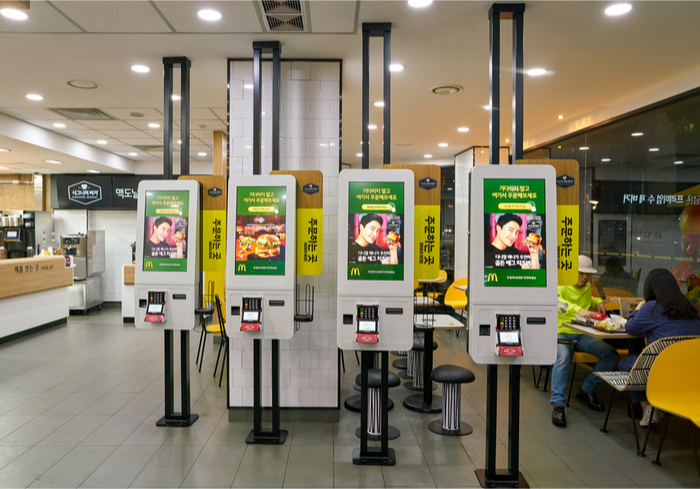
Retailers and retail landlords are reporting strong first-quarter earnings results, beating analysts’ expectations in many cases. Buoyed by strong consumer spending and its resilience in the U.S. and abroad, companies such as McDonald’s are off to a positive start in 2018.
As quick-service restaurants (QSRs) look to the future, digital innovations such as self-serve kiosks and delivery are on top of mind. But mall owners and operators are occupied with a different focus: what to do with closing anchor tenants that once filled valuable space in their malls. (Some are choosing to redevelop stores for other uses — restaurants included.)
Here’s how McDonald’s, Simon Property Group and Grubhub saw success in the first quarter and what their executives said is in store for the future.
McDonald’s
McDonald’s surpassed analysts’ expectations with its first-quarter results on both the top and bottom lines on Monday (April 30). Same-store restaurant sales also increased, Reuters reported, on what has been billed as a multiyear turnaround effort.
Same-store sales were up 2.9 percent in the United States. Management noted on the conference call with analysts following the earnings report that there was a “positive comp gap” between the company and quick-service restaurant peers of as much as 270 basis points.
McDonald’s is using digital menu boards, mobile apps and self-order kiosks to make customers aware of product selection and food quality. The QSR has been particularly thoughtful when it comes to the placement of its kiosks.
“What’s really important about the self-order kiosk is not just the customer-facing user interface but actually physically where you position them in a restaurant,” McDonald’s President and Chief Executive Officer Steve Easterbrook said in the company’s earnings call. “It [also] provides another ordering option for a customer apart from the front counter.”
In terms of delivery, the QSR wouldn’t provide exact numbers on how this order segment contributed to its U.S. comp sales. But McDonald’s Chief Financial Officer Kevin Ozan said that delivery did contribute to the company’s U.S. comp in the first quarter “as it did at the end of the year last year.”
Ozan believes that momentum will continue: “We would hope and expect that to continue to grow as sales grow on the delivery side,” he said.
Simon Property Group
Has the death of the American shopping mall been slightly exaggerated? While mall owners and operators face their share of challenges, Simon Property Group’s revenues clocked in at $1.4 billion on Friday (April 27). That top-line figure beat the consensus estimate of $1.38 billion, according to news from Retail Dive.
Still, the earnings announcement comes as mall operators are trying to reboot in an era when the department store is no longer the anchor tenant of choice at many locations and brands like Macy’s and JCPenney continue to shutter brick-and-mortar stores.
To fill vacancies left behind by anchor tenants, Simon Property Group is thinking outside the box. In some cases, the retailer is demolishing existing stores to create new uses of the land. For example, the company has redevelopment plans for the land left behind by a JCPenney that will be demolished in Pennsylvania.
“That gives us 17 acres of land adjacent to King of Prussia mall and that is going to be a significant mixed-use project with hotel, office, residential, restaurants, retail and amenities,” Simon Property Group President and COO Rick Sokolov said in the company’s earnings call. “And so, that’s a major opportunity for us to substantially upgrade what is already one of the best properties in the United States.”
Grubhub
Grubhub is growing, fueled by “strong momentum in tier two and smaller markets,” CEO Matt Maloney said in a post-earnings conference call on Tuesday (May 1). However, the online order and delivery service’s sales and active daily orders came up short of estimates. Despite this slip-up, the company’s first-quarter revenue reached $232.6 million, higher than analyst predictions of about $229 million.
To further its expansion efforts, Grubhub has rolled out its food delivery service to several smaller cities, such as Charleston, South Carolina; Honolulu, Hawaii; Memphis, Tennessee; Shreveport, Louisiana and Portland, Maine. As the company expands into new markets, it’s starting to recognize economies of scale, Maloney said.
“It’s the ability specifically to staff, to dispatch, to route and batch orders,” Maloney said. “Basically, as throughput of the network goes up, our driver cost per order goes down.”
Maloney also mentioned the company’s payment integration with Venmo through its Grubhub, Seamless and Eat24 platforms. While he didn’t offer specific metrics, Maloney said the company is excited about the future of online ordering. “We see tremendous potential for online ordering in the U.S. as consumer habits shift and awareness of our product grows,” he said.
The Road Ahead
Earnings season is still young: There are still close to 700 companies that will report their earnings between Wednesday (May 2) and Friday (May 4), including Shake Shack, Overstock.com and Wayfair.
Will they fare as well as McDonald’s, Grubhub and Simon Property Group? Tune in to find out.